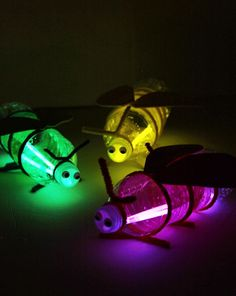Our Lessons For the Week! Bugs, Bugs, Bugs. Let’s explore more bugs!
What is our theme? Light bugs
What is the lesson (overall purpose)?
To learn how and why light bugs light up
MA Guidelines/Standards:
SEL7: The child will demonstrate the ability to communicate with others in a variety of ways.
SEL8: The child will engage socially, and build relationships with other children and with adults.
APL 2: The child will demonstrate eagerness and curiosity as a learner.
APL4: The child will demonstrate creativity in thinking and use of materials.
Songs, Books & Videos (Motivational Techniques)
Vidoe: Facts about light bugs https://youtu.be/Ts7JlS3M2S4
Materials
1 water bottle
1 glow stick
googly eyes
paper
glue
black permanent marker
1 pipe cleaner
Activity (Procedure):
Take your paper, cut 2 raindrops look alike shapes for the wings of the light bug.
Glue the wings on the side of the water bottle.
Glue the googly eyes on the top part of the bottle cap.
Let the eyes and wings dry.
After everything is dry take your glow stick (make sure to follow the directions on the package for the glow stick) after snapping the glow stick and it’s all lit up. Open your water bottle and place the glow stick inside the bottle. Make sure to close your water bottle with the glow stick inside. Then go outside in the dark and fly your light bug ( make sure to have a parent with you
Activity Wrap Up: ask your child questions about the video like, what is another word for light bugs? Why do they glow? What does cannibal mean? (that’s what they are)
How do I know what my child is learning? (Assessment)
Are they able to close the water bottle on their own or with assistance
How can you extend this activity? (Modifications)
You can give them markers to to decorate their light bug
Helpful Hints: (Pitfalls & Solutions)
If you don’t have googly eyes, they can draw the eyes with a marker
What is our theme? Light bugs
What is the lesson (overall purpose)?
To learn how and why light bugs light up
MA Guidelines/Standards:
SEL7: The child will demonstrate the ability to communicate with others in a variety of ways.
SEL8: The child will engage socially, and build relationships with other children and with adults.
APL 2: The child will demonstrate eagerness and curiosity as a learner.
APL4: The child will demonstrate creativity in thinking and use of materials.
Songs, Books & Videos (Motivational Techniques)
Vidoe: Facts about light bugs https://youtu.be/Ts7JlS3M2S4
Materials
1 water bottle
1 glow stick
googly eyes
paper
glue
black permanent marker
1 pipe cleaner
Activity (Procedure):
Take your paper, cut 2 raindrops look alike shapes for the wings of the light bug.
Glue the wings on the side of the water bottle.
Glue the googly eyes on the top part of the bottle cap.
Let the eyes and wings dry.
After everything is dry take your glow stick (make sure to follow the directions on the package for the glow stick) after snapping the glow stick and it’s all lit up. Open your water bottle and place the glow stick inside the bottle. Make sure to close your water bottle with the glow stick inside. Then go outside in the dark and fly your light bug ( make sure to have a parent with you
Activity Wrap Up: ask your child questions about the video like, what is another word for light bugs? Why do they glow? What does cannibal mean? (that’s what they are)
How do I know what my child is learning? (Assessment)
Are they able to close the water bottle on their own or with assistance
How can you extend this activity? (Modifications)
You can give them markers to to decorate their light bug
Helpful Hints: (Pitfalls & Solutions)
If you don’t have googly eyes, they can draw the eyes with a marker

 RSS Feed
RSS Feed
